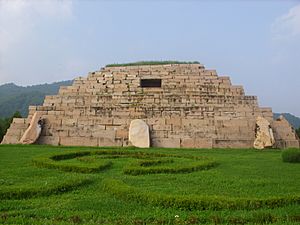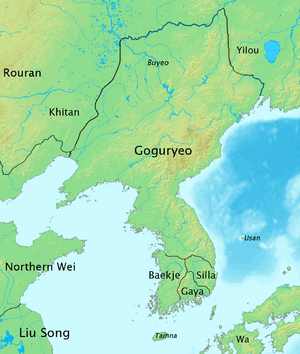Jangsu of Goguryeo facts for kids
Quick facts for kids King Jangsu |
|
|---|---|
| Monarch of Goguryeo | |
| Reign | 413-491 (78 years) |
| Predecessor | Gwanggaeto |
| Successor | Munjamyeong of Goguryeo |
| Born | 394 |
| Died | 491 (aged 96–97) |
| Issue | Crown Prince Juda |
| Father | Gwanggaeto |
| Jangsu of Goguryeo | |
| Hangul | |
|---|---|
| Hanja | |
| Revised Romanization | Jangsu-wang |
| McCune–Reischauer | Changsu-wang |
| Birth name | |
| Hangul | |
| Hanja | |
| Revised Romanization | Georyeon or Yeon |
| McCune–Reischauer | Kǒryǒn or Yǒn |
Jangsu of Goguryeo (born 394, died 491) was the 20th monarch (ruler) of Goguryeo. This was the northernmost of the Three Kingdoms of Korea. He was born in 394 and was the oldest son of King Gwanggaeto.
Jangsu became the crown prince in 408. When his father passed away in 413, Jangsu became king at just 19 years old. He ruled for an amazing 78 years, until he was 97! This was the longest reign in East Asian history. His special name, "Jangsu," means "Long Life."
King Jangsu's time was the "golden age" of Goguryeo. It became a very strong empire and a major power in East Asia. He kept expanding his father's lands through battles. But he was also very good at diplomacy, which means handling relations with other countries peacefully.
Like his father, Jangsu helped unite the Three Kingdoms of Korea in a loose way. During his long rule, Goguryeo also improved its government, economy, and other systems. He is also famous for building the Gwanggaeto Stele, a huge stone monument for his father. Jangsu even changed Goguryeo's official name to "Goryeo," which is where the name Korea comes from today.

Contents
Early Years as King
When Jangsu first became king, he worked hard to make the empire stable. His father's conquests had made Goguryeo grow very quickly.
Jangsu built a grand tomb for his father, Gwanggaeto the Great. He also put up a huge 6-meter-tall tombstone. This stone was carved with all of his father's great achievements. Today, it is known as the Gwanggaeto Stele.
In 427, King Jangsu moved Goguryeo's capital city. It moved from Gungnae Fortress (in modern-day Ji'an) to Pyongyang. Pyongyang was a better place for a big, growing capital. This move helped Goguryeo become very rich and culturally advanced.
Dealing with Other Countries
When Jangsu's father ruled, China was divided into many smaller states. These states were often fighting each other. Goguryeo had even taken over some Chinese lands.
But when Jangsu became king, China was becoming more unified. A new powerful state called Northern Wei was growing. Jangsu was very clever. He used the situation in China to his advantage. He played the northern and southern Chinese states against each other.
A state called Northern Yan was threatened by Northern Wei. So, Northern Yan made an alliance with Goguryeo. This allowed Jangsu to focus his military on the Korean peninsula.
The southern Chinese dynasty, Liu Song, wanted Northern Wei to be weaker. So, they encouraged Goguryeo to fight Northern Wei. But Jangsu had his own plans. In 438, Goguryeo captured the emperor of Northern Yan. Liu Song was angry and threatened war. But Jangsu ignored them and executed the emperor.
Liu Song troops attacked Goguryeo but were easily defeated. Jangsu then sent gifts to the Liu Song emperor. This helped Liu Song in their war against Northern Wei. This way, Goguryeo could focus on its neighbors, Baekje and Silla. Jangsu even sent more gifts to Liu Song later to encourage them to attack Northern Wei again. Northern Wei was annoyed but had to keep peace with Goguryeo.
Jangsu also kept good relations with Northern Wei. They formed a formal connection in 435. This was helpful when Goguryeo fought Baekje. Baekje had secretly asked Northern Wei for help against Goguryeo. But Northern Wei did not get involved.
In 479, Jangsu made friends with the Rouran Khaganate. This helped him keep Northern Wei in check. After making peace with the Rourans, Jangsu attacked the Khitans and the Didouyu with his Rouran allies.
After the Khitans gave up to Goguryeo, Jangsu sent gifts to both Northern Wei and Southern Qi. Southern Qi had taken over southern China. Both Qi and Wei wanted a stronger relationship with Goguryeo. Northern Wei even treated Goguryeo's visitors like their own important guests.
But Jangsu kept sending visitors to Southern Qi as well. This made the Northern Wei emperor angry. He even tried to stop Goguryeo's visitors from reaching Qi. But Jangsu didn't care and kept sending them. This showed how successful Jangsu's diplomacy was. He used the rivalries between Chinese states to help Goguryeo.
Goguryeo and the northern Chinese states stayed peaceful for a long time after this.
Relations with Korean Neighbors
Baekje and Silla faced strong attacks from Goguryeo. To survive, they formed an alliance through marriage in 433. This alliance lasted over 100 years. It was the main reason Goguryeo could not conquer the whole Korean peninsula.
The Gaya states were in a tough spot. They were stuck between Baekje and Silla. Because of this, they couldn't grow into a strong nation.
In 472, King Gaero of Baekje asked Northern Wei for military help against Goguryeo. But he didn't get the help he wanted. Jangsu then secretly planned to attack Baekje. Even though Baekje had lost battles to Jangsu's father, it was still powerful.
To weaken Baekje, Jangsu sent a Buddhist monk named Dorim. Dorim's secret mission was to cause trouble in Baekje. King Gaero liked Dorim and played the game baduk with him every day. Dorim convinced King Gaero to spend huge amounts of money on building projects. This made Baekje's treasury weak.
In 475, Jangsu launched a huge invasion of Baekje. He attacked by land and sea. King Gaero was not ready for the attack because Dorim had gathered information. Jangsu quickly captured Baekje's capital, Wiryeseong, and killed King Gaero. Jangsu then burned the capital and other cities he conquered.
Baekje had to move its capital to Ungjin (modern-day Gongju). This new capital was in the mountains, which offered natural protection. This war gave Goguryeo control of the Han River valley. This area was very important for trade and military power in Korea. Baekje had been strong for hundreds of years because it controlled this region. But after losing it to Goguryeo, Baekje lost its power on the peninsula.
After his success in Baekje, Jangsu turned to Silla. Silla had been a vassal state (a country that owes loyalty to a stronger one) of Goguryeo since Jangsu's father defeated invaders in 400. To make sure Silla stayed loyal, Jangsu demanded that the younger brother of King Nulji of Silla become a political hostage.
However, King Nulji broke off relations with Goguryeo in 454. Jangsu invaded Silla in 468, taking parts of Gangwon Province. He attacked again in 489, capturing seven walled cities and expanding into North Gyeongsang Province. After his victory over Silla, Jangsu put up a stone monument in Chungju. It praised his and his father's achievements. This monument is still there today. It is the only Goguryeo stone monument left in the Korean peninsula.
Death and Legacy
King Jangsu died in 491, at the age of 97. His special name, "Jangsu," means "Long Life" in Korean. During his reign, Goguryeo was at its strongest. Its lands stretched from Inner Mongolia all the way to modern-day North Chungcheong Province in South Korea, south of the Han River basin.
Modern Depictions
- Age of Empires: World Domination, a mobile game, includes Jangsu as a hero for the Korean civilization.
- Portrayed by Jung Yun-seok in the 2007 MBC TV series The Legend.
See also
 In Spanish: Jangsu de Goguryeo para niños
In Spanish: Jangsu de Goguryeo para niños


